This article gives interesting light parameters of an ordinary halogen light spot of 35 W. It serves as a nice comparison article for the newer type of light bulbs like LED light bulbs. An Eulumdat file is added in this article.
See this overview for a comparison with other light bulbs.
Summary measurement data
| parameter | meas. result | remark |
|---|---|---|
| Color temperature | 2620 K | Warm white |
| Luminous intensity Iv | 307 Cd | |
| Beam angle | 27 deg | |
| Power P | 35 W | |
| Power Factor | 1.0 | For every 1 kWh net power consumed, there has been 0.1 kVAhr for reactive power. |
| Luminous flux | 138 lm | |
| Luminous efficacy | 4 lm/W | |
| CRI_Ra | 100 | Color Rendering Index. |
| Coordinates chromaticity diagram | x=0.4672 and y=0.4125 | |
| Fitting | GU10 | |
| D x H external dimensions | 50 x 56 mm | External dimensions of the light bulb. |
| D luminous area | 42 mm | Dimensions of the luminous area (used in Eulumdat file). This is equal to the size of the glass of the front of the light bulb. |
| General remarks | The ambient temperature during the whole set of measurements was 24-27 deg C.
Warm up effect: during the warm up time the illuminance decreases with 6 %. Voltage dependency: there is a linear dependency of illuminance and power consumption on the voltage. The Eulumdat file can be found via this link. This light bulb is measured on dim-abilty, and interesting parameters are put together in one graph, as function of the mechanical dim position. |
|
Eulumdat light diagram
An interesting graph is the light diagram, indicating the intensity in the C0-C180 and the C90-C270 plane. This light diagram below comes from the program Qlumedit, that extracts these diagrams from an Eulumdat file.
The light diagram giving the radiation pattern.
It indicates the luminous intensity around the light bulb. This light diagram is symmetrical around the z-axis.
The unit is Cd/1000lm, meaning the intensity in Cd assuming there would be 1000 lumen in the measured light bulb. This enables comparing different types of light bulbs.
Illuminance Ev at 1 m distance, or luminous intensity Iv
Herewith the plot of the averaged luminous intensity Iv as a function of the inclination angle with the light bulb.
The radiation pattern of the light bulb.
This radiation pattern is the same as the one given earlier. This is because in this light bulb’s case, the radiation pattern is symmetric around the z-axis, meaning that the averaged pattern given here is the same as the extraction of the Eulumdat file.
These averaged values are used (later) to compute the lumen output.
Intensity data of every measured turn angle at each inclination angle.
This plot shows per inclination angle the intensity measurement results for each turn angle at that inclination angle. There is a large spread at the small inclination angles. The light spot was positioned straightly, but the filament was not straight in its bulb.
The blue oval indicates the filament that wasn’ t straight.
As the average values of illumination per inclination angle will be used for further computations, there is no effect on the further results.
When using the average values per inclination angle, the beam angle can be computed, being 27 degrees.
Luminous flux
With the averaged illuminance data at 1 m distance, taken from the graph showing the averaged radiation pattern, it is possible to compute the luminous flux.
The result of this computation for this light spot is a luminous flux of 138 lm.
Luminous efficacy
The luminous flux being 138 lm, and the power of the lightbulb being 35 W, yields a luminous efficacy of 4 lm/W.
A power factor of (close to) 1.0 means that for every 1 kWh net power consumed, a reactive component of 0.1 kVAr was needed.
| Light bulb voltage | 230 V |
| Light bulb current | 155 mA |
| Power P | 35.3 W |
| Apparent power S | 35.5 VA |
| Power factor | 1.0 |
Color temperature and Spectral power distribution
The spectral power distribution of this light bulb.
The measured color temperature is about 2620 K which is warm white.
This color temperature is measured straight underneath the light bulb. Below a graph showing the color temperature for different inclination angles.
Color temperature as a function of inclination angle.
The color temperature is given for inclination angles up to 35 degrees since at larger inclination angles there is too little illumination.
The value remains constant within 2 %.
Chromaticity diagram
The chromaticity space and the position of the lamp’s color coordinates in it.
The light coming from this lamp is on top of the Planckian Locus (the black path in the graph).
Its coordinates are x=0.4672 and y=0.4125.
Color Rendering Index (CRI) or also Ra
Herewith the image showing the CRI as well as how well different colors are represented (rendered). The higher the number, the better the resemblance with the color when a black body radiator would have been used (the sun, or an incandescent lamp).
Each color has an index Rx, and the first 8 indexes (R1 .. R8) are averaged to compute the Ra which is equivalent to the CRI.
CRI of the light of this lightbulb.
The value of 100 is higher than 80 which is considered a minimum value for indoor usage.
Note: the chromaticity difference is 0.0003 indicates the distance to the Planckian Locus. Its value is lower than 0.0054, which means that the calculated CRI result is meaningful.
Voltage dependency
The dependency of a number of lamp parameters on the lamp voltage is determined. For this, the lamp voltage has been varied and its effect on the following lamp parameters measured: illuminance E_v [lx], color temperature CT or correlated color temperature CCT [K], the lamppower P [W] and the luminous efficacy [lm/W].
Lamp voltage dependencies of certain light bulb parameters, where the value at 230 V is taken as 100 %.
The consumed power and the illuminance vary largely when the voltage varies between 200 – 250 V. This variation is linear.
When the voltage at 230 V varies with + and – 5 V, then the illuminance varies with less than + and – 8 %, which might be visible when the voltage changes abruptly.
Warm up effects
After switch on of a cold lamp, the effect of heating up of the lamp is measured on illuminance E_v [lx], color temperature CT or correlated color temperature CCT [K], the lamppower P [W] and the luminous efficacy [lm/W].
Effect of warming up on different light bulb parameters. At top the 100 % level is put at begin, and at bottom at the end.
During warmup time of 5 minutes, the illumination decreases with 6 %.
Dim-ability
This chapter explains how well this light bulb be dimmed. It is quite common to dim halogen light bulbs. The dimmer used is a leading edge dimmer.
The measurements taken show Power, Illuminance, Color Temperature and the computed value of Efficacy as function of the mechanical dim position of the dimmer.
Lamp parameters as function of the mechanical position of the dimmer
The value 100 corresponds to minimum dimming, and the value 0 corresponds to maximum dimming. This can be compared with the extreme mechanical positions of the mechanical knob to adjust the dimming function.
The graphs title is “towards more intensity” which means that measurements taken started with the light bulb in max dimming position, towards minimum dimming position. Also the mesurements were done going towards less intensity, and the results were the same for this lightbulb.
When dimming more and more, the illuminance drops quicker than the power consumption does resulting an a decrease of efficacy.
The color temperature decreases as well with more dimming.

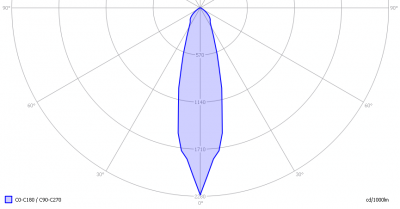
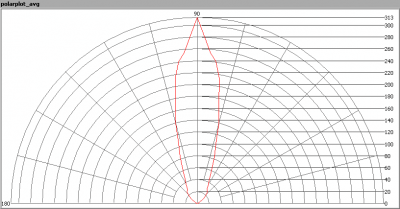
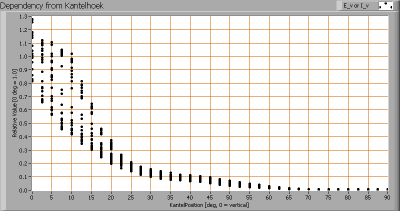
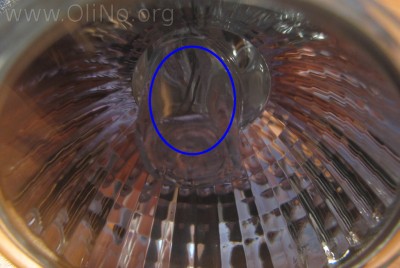
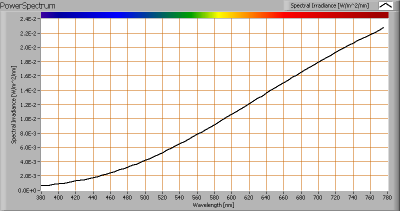
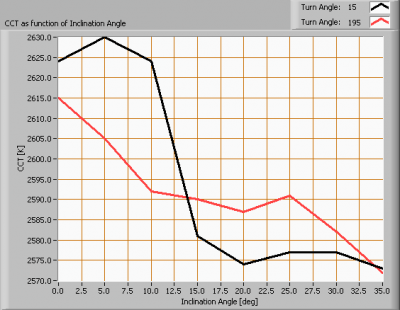
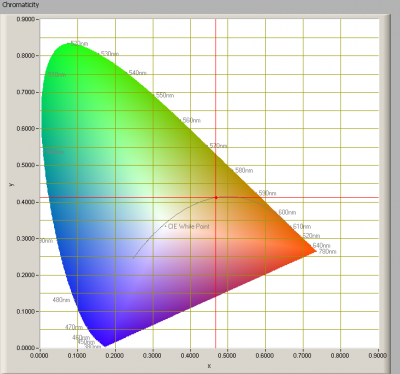
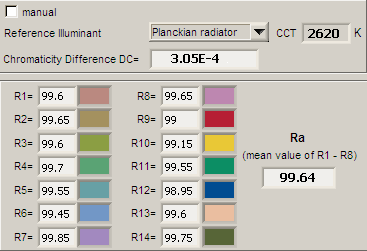
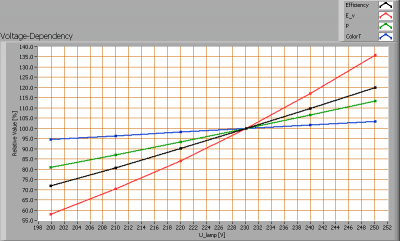
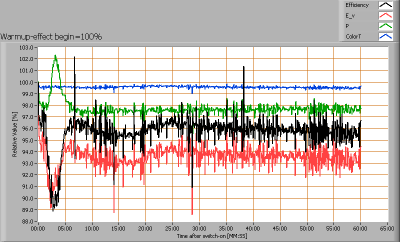
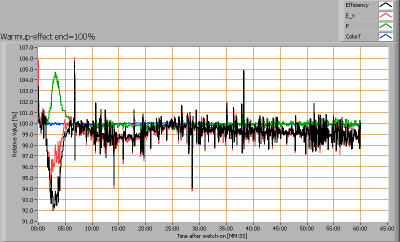
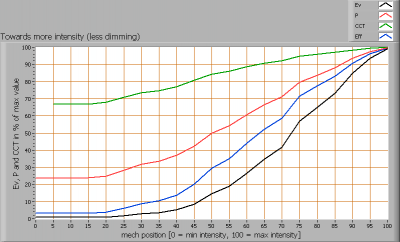





2 replies on “35W GU10 Halogen light spot”
I am very surprised by some of these data. The color temperature is below what is usually reported for a simple (non-halogen) bulb and I thought halogen lamps operate at higher temperature, suggesting higher color temperature. Of course, the reflector could shift the color temperature downward, but I would expect the opposite for coatings designed to leak long wavelengths. Was this a quality lamp and was it running at its proper voltage? The behavior suggests either poor quality or a problem with voltage.
@ Robert.
This lamp is not a high quality lamp. One can see that at the low lumen efficacy. Also the low temperature will lead to the low efficacy. This lamp will most liley have a long lifetime as it burns at relatively low temperature.
I have also measured quality halogen lamps like Philips’. Then I could differentiate between cold beam halogen lamps with a CCT of 3000 K which were at about 20 lm/W. These will have a life comparable to a normal light bulb of 2700 K I expect. Furthermore these have a rather high efficacy but the 3000 K will not always be attractive. Also one can find quality warm beam halogen lamps and then you are back at around 2700 K. The efficacy drops again but lifetime increases.
With the lamp measured in this article however, I expect it to be af not too high quality (it was a no-name) and I assure that the voltage used was 230 V AC as it is kep constant with help of a variac and every second the value is measured and adjusted.